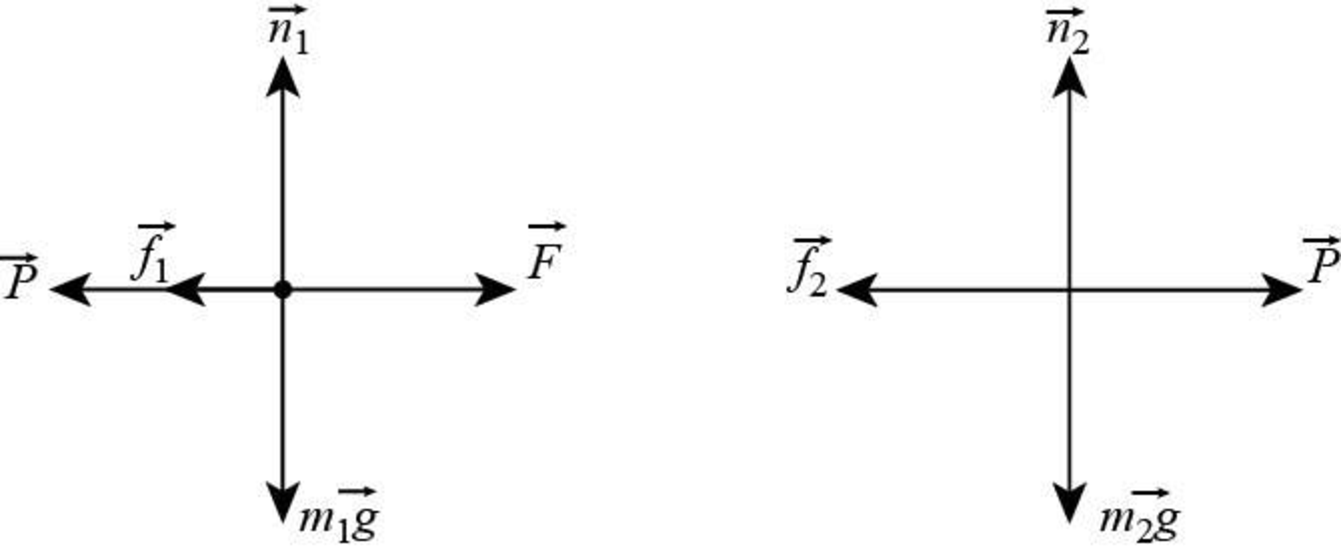
Concept explainers
Two blocks of masses m1 and m2, are placed on a table in contact with each other as discussed in Example 5.7 and shown in Figure 5.13a. The coefficient of kinetic friction between the block of mass m1 and the table is μ1, and that between the block of mass m2 and the table is μ2. A horizontal force of magnitude F is applied to the block of mass m1. We wish to find P, the magnitude of the contact force between the blocks. (a) Draw diagrams showing the forces for each block. (b) What is the net force on the system of two blocks? (c) What is the net force acting on m1? (d) What is the net force acting on m2? (e) Write Newton’s second law in the x direction for each block. (f) Solve the two equations in two unknowns for the acceleration a of the blocks in terms of the masses, the applied force F, the coefficients of friction, and g. (g) Find the magnitude P of the contact force between the blocks in terms of the same quantities.

(a)
The free body diagram of each block with forces.
The free body diagram of an object represents the direction and magnitude of forces acting on the body.
Explanation of Solution
The mass of block
The free body diagram of the book is given below.

Figure (1)
The sum of all vertical forces is zero because the block moves on a horizontal surface. So the vertical acceleration,
Write the net force in the y-direction for mass
Here,
Write the net force in the y-direction for mass
Here,
Write the equation for kinetic friction for block
Here,
Write the equation for kinetic friction for block
Here,
In the figure,
Conclusion:
Therefore, the free body diagram of each block to show the forces is given in figure I.
(b)
The net force on the system of two blocks.
Answer to Problem 5.79AP
The net force on the system of two blocks is the external force applied minus the frictional force.
Explanation of Solution
Write the expression for the net force in x-direction for the system of two blocks from the figure I,
Here,
Conclusion:
Therefore, the net force on the system of two blocks is the external force applied minus the frictional force.
(c)
The net force acting on
Answer to Problem 5.79AP
The net force acting on
Explanation of Solution
Write the expression for the net force in x-direction for the system of two blocks from the figure I,
Here,
Conclusion:
Therefore, the net force acting on
(d)
The net force acting on
Answer to Problem 5.79AP
The net force acting on
Explanation of Solution
Write the expression for the net force in x-direction for the system of two blocks from the figure I,
Here,
Conclusion:
Therefore, the net force acting on
(e)
The Newton’s second law in the
Answer to Problem 5.79AP
The Newton’s second law in the
Explanation of Solution
The block has on a horizontal acceleration
Write the Newton’s second law for block
Substitute
Substitute
Write the Newton’s second law for block
Substitute
Substitute
Conclusion:
Therefore, the Newton’s second law in the
(f)
The acceleration of the blocks.
Answer to Problem 5.79AP
The acceleration of the blocks is
Explanation of Solution
Write the Newton’s second law is for block
Write the Newton’s second law is for block
Conclusion:
Add the equation (I) and equation (II) and solve for
Therefore, the acceleration of the blocks is
(g)
The magnitude of the contact force between the blocks in terms of acceleration, mass, applied force and the friction coefficient.
Answer to Problem 5.79AP
The magnitude
Explanation of Solution
Recall the equation (II).
Substitute
Conclusion:
Therefore, the magnitude
Want to see more full solutions like this?
Chapter 5 Solutions
Bundle: Physics for Scientists and Engineers, Technology Update, 9th Loose-leaf Version + WebAssign Printed Access Card, Multi-Term
- Portfolio Problem 2. A particle of mass m slides in a straight line (say along i) on a surface, with initial position x ©0 and initial velocity Vo > 0 at t = 0. The = particle is subject to a constant force F = -mai, with a > 0. While sliding on the surface, the particle is also subject to a friction force v Ff = -m fo = −m fov, with fo > 0, i.e., the friction force has constant magnitude mfo and is always opposed to the motion. We also assume fo 0, and solve it to find v(t) and x(t). How long does it take for the particle to come to a stop? How far does it travel? (b) After coming to a stop, the particle starts sliding backwards with negative velocity. Write the equation of motion in this case, and solve it to find the time at which the particle returns to the original position, x = 0. Show that the final speed at x 0 is smaller than Vo. = Express all your answers in terms of a, fo and Vo.arrow_forward= Portfolio Problem 1. A particle of mass m is dropped (i.e., falls down with zero initial velocity) at time t 0 from height h. If the particle is subject to gravitational acceleration only, i.e., a = −gk, determine its speed as it hits the ground by solving explicitly the expressions for its velocity and position. Next, verify your result using dimensional analysis, assuming that the general relation is of the form v = khag³m, where k is a dimensionless constant.arrow_forwardReview Conceptual Example 2 before attempting this problem. Two slits are 0.158 mm apart. A mixture of red light (wavelength = 693 nm) and yellow-green light (wavelength = 567 nm) falls on the slits. A flat observation screen is located 2.42 m away. What is the distance on the screen between the third-order red fringe and the third-order yellow- green fringe? m = 3 m = 3 m= 0 m = 3 m = 3 Fringes on observation screenarrow_forward
- In the figure below, a semicircular conductor of radius R = 0.260 m is rotated about the axis AC at a constant rate of 130 rev/min. A uniform magnetic field of magnitude 1.22 T fills the entire region below the axis and is directed out of the page. In this illustration, a wire extends straight to the right from point A, then curves up and around in a semicircle of radius R. On the right side of the semicircle, the wire continues straight to the right to point C. The wire lies in the plane of the page, in a region of no magnetic field. Directly below the axis A C is a region of uniform magnetic field pointing out of the page, vector Bout. If viewed from the right, the wire can rotate counterclockwise, so that the semicircular part can rotate into the region of magnetic field. (a) Calculate the maximum value of the emf induced between the ends of the conductor. V(b) What is the value of the average induced emf for each complete rotation? Consider carefully whether the correct answer is…arrow_forwardA coil of 15 turns and radius 10.0 cm surrounds a long solenoid of radius 2.20 cm and 1.00 103 turns/meter (see figure below). The current in the solenoid changes as I = 6.00 sin(120t), where I is in amperes and t is in seconds. Find the induced emf (in volts) in the 15-turn coil as a function of time. (Do not include units in your answer.) =arrow_forwardA coil of 15 turns and radius 10.0 cm surrounds a long solenoid of radius 1.80 cm and 1.00 103 turns/meter (see figure below). The current in the solenoid changes as I = 5.00 sin(120t), where I is in amperes and t is in seconds. Find the induced emf (in volts) in the 15-turn coil as a function of time. (Do not include units in your answer.) =arrow_forward
- Which vowel does this graph represent (”ah,” “ee,” or “oo”)? How can you tell? Also, how would you be able to tell for the other vowels?arrow_forwardConcept Simulation 26.4 provides the option of exploring the ray diagram that applies to this problem. The distance between an object and its image formed by a diverging lens is 5.90 cm. The focal length of the lens is -2.60 cm. Find (a) the image distance and (b) the object distance.arrow_forwardA bat is flying toward a cave wall at 27.0 m/s. What is the frequency of the reflected sound that it hears, assuming it emits sound at 52.0 kHz? The speed of sound is 341.5 m/s. Multiple Choice о 60.9 kHz О 56.5 kHz о 61.3 kHz О 56.1 kHzarrow_forward
- Compare the slope of your Data Table 2 graph to the average wavelength (Ave, l) from Data Table 2 by calculating the % Difference. Is the % Difference calculated for the wavelength in Data Table 2 within an acceptable % error? Explain why or why not?arrow_forwardThe slope of a graph of velocity, v, vs frequency, f, is equal to wavelength, l. Compare the slope of your Data Table 1 graph to the average wavelength (Ave, l) from Data Table 1 by calculating the % Difference.arrow_forwardExamine the slope of the line on the graph created using the data in Data Table 4 of Period, T2 vs L, the slope of the line is a constant containing the acceleration due to gravity, g. Using the slope of your line, determine the experimental value for g. Compare the value you determined for g from the slope of the graph to the expected value of 9.81 m/s2 by calculating the percent error.arrow_forward
 Physics for Scientists and Engineers: Foundations...PhysicsISBN:9781133939146Author:Katz, Debora M.Publisher:Cengage Learning
Physics for Scientists and Engineers: Foundations...PhysicsISBN:9781133939146Author:Katz, Debora M.Publisher:Cengage Learning Principles of Physics: A Calculus-Based TextPhysicsISBN:9781133104261Author:Raymond A. Serway, John W. JewettPublisher:Cengage Learning
Principles of Physics: A Calculus-Based TextPhysicsISBN:9781133104261Author:Raymond A. Serway, John W. JewettPublisher:Cengage Learning Classical Dynamics of Particles and SystemsPhysicsISBN:9780534408961Author:Stephen T. Thornton, Jerry B. MarionPublisher:Cengage Learning
Classical Dynamics of Particles and SystemsPhysicsISBN:9780534408961Author:Stephen T. Thornton, Jerry B. MarionPublisher:Cengage Learning Physics for Scientists and Engineers with Modern ...PhysicsISBN:9781337553292Author:Raymond A. Serway, John W. JewettPublisher:Cengage Learning
Physics for Scientists and Engineers with Modern ...PhysicsISBN:9781337553292Author:Raymond A. Serway, John W. JewettPublisher:Cengage Learning College PhysicsPhysicsISBN:9781305952300Author:Raymond A. Serway, Chris VuillePublisher:Cengage Learning
College PhysicsPhysicsISBN:9781305952300Author:Raymond A. Serway, Chris VuillePublisher:Cengage Learning College PhysicsPhysicsISBN:9781285737027Author:Raymond A. Serway, Chris VuillePublisher:Cengage Learning
College PhysicsPhysicsISBN:9781285737027Author:Raymond A. Serway, Chris VuillePublisher:Cengage Learning





